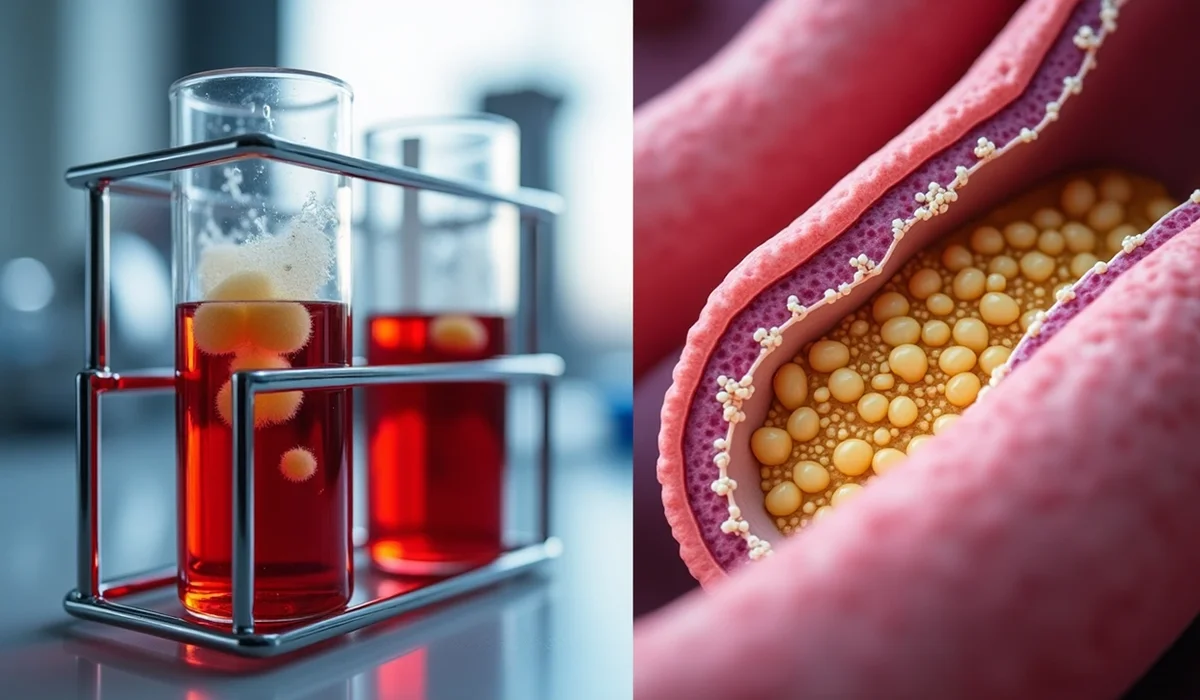Your heart health depends on understanding cholesterol levels, though these numbers might seem puzzling. A cholesterol test actually measures several different components. Medical experts identify High-density lipoprotein (HDL) as “good” cholesterol and Low-density lipoprotein (LDL) as “bad” cholesterol.
Health experts recommend that adults should maintain their total cholesterol below 200 mg/dL. The specific types of cholesterol play an equally vital role as the total amount. Your LDL cholesterol should stay under 100 mg/dL to maintain optimal health. Men need HDL cholesterol above 40 mg/dL, while women should aim for levels above 50 mg/dL. Your triglyceride levels should remain below 150 mg/dL.
These measurements serve a real purpose and directly affect your heart’s wellbeing. Fatty deposits build up in your arteries because of LDL cholesterol, which raises your risk of heart attacks and strokes. HDL cholesterol works differently – it helps your body by moving LDL from arteries to the liver for disposal. This piece explains these numbers’ significance and shows you ways to achieve healthy cholesterol levels that benefit your long-term health.
What is Cholesterol and Why It Matters
People often think badly of cholesterol, but this waxy, fat-like substance is a vital building block in our bodies [1][2]. Looking at it as just “good” or “bad” misses the point – cholesterol is everything in our body that needs the right balance.
Cholesterol’s role in the body
Our bodies depend on cholesterol to do several important jobs. It makes up the foundations of cell membranes and gives cells their structure and flexibility [1][2]. Cholesterol is also vital to produce hormones, including stress and sex hormones that control many body processes [1][3].
The body uses cholesterol to create vitamin D, which keeps bones healthy and helps immune function [1][4]. It also helps make bile, which we need to digest fats from food [2][4].
Our liver makes about 80% of all the cholesterol we need [2][3]. We get the rest from animal foods like meat, poultry, and dairy products [3][2].
How excess cholesterol causes health issues
While cholesterol is important, too much of it – especially certain types – can create serious health problems. It moves through our blood attached to proteins, which scientists call lipoproteins [1].
Low-density lipoprotein (LDL) gets called “bad cholesterol” and with good reason too. High levels can make plaque build up in arteries [3][2]. This buildup, called atherosclerosis, happens when extra LDL mixes with other substances to form fatty deposits that stick to artery walls [5][6].
These deposits get hard and make arteries narrow over time, which limits blood flow through the body [5][4]. The heart must then work harder to push blood through these tight spaces, which can raise blood pressure [6].
A completely blocked artery can result from growing plaque. Sometimes, pieces of plaque break off and create dangerous blood clots [5][4]. These blockages in heart arteries can lead to angina (chest pain) or heart attacks [5][4]. The same thing happens with brain arteries, which can cause strokes [4][6].
Most adults should keep their LDL cholesterol under 100 mg/dL to stay healthy. People with heart risks should aim for less than 70 mg/dL [1][2].
HDL vs LDL Cholesterol: Key Differences
Cholesterol flows through our bloodstream in two main forms that affect heart health very differently. These differences explain why some types of cholesterol protect our hearts while others can be dangerous.
HDL (Good Cholesterol): Function and Benefits
High-density lipoprotein (HDL) has earned its nickname “good cholesterol” [7]. This amazing substance acts like a cleanup crew in your arteries and takes excess cholesterol back to the liver to be eliminated [8]. HDL removes harmful LDL cholesterol right from your artery walls to reduce plaque buildup [9].
Your HDL levels should be above 60 mg/dL to protect your heart effectively [7]. Women need higher HDL levels of at least 50 mg/dL, while men need a minimum of 40 mg/dL [7]. HDL does more than remove cholesterol – it fights inflammation and stops blood clots from forming [10].
LDL (Bad Cholesterol): Risks and Effect
Low-density lipoprotein (LDL) delivers cholesterol to body tissues but creates problems when levels get too high [8]. Too much LDL leads to plaque buildup in arteries (atherosclerosis) that narrows blood vessels and raises your risk of heart attacks, strokes, and peripheral artery disease [8].
Adults without heart disease should keep their LDL below 130 mg/dL [1]. People with cardiovascular conditions need even lower levels – under 100 mg/dL or even 70 mg/dL [11]. Small dense LDL particles are more dangerous than larger ones because they penetrate artery walls easily and resist removal [12].
Triglycerides: The Third Lipid to Watch
Triglycerides are not cholesterol but represent another vital blood fat we need to monitor [8]. These fat molecules store extra calories and energy from what we eat [13]. High triglycerides combined with poor cholesterol readings substantially increase your risk of heart disease [8].
Healthy triglyceride readings should stay under 150 mg/dL [13]. Very high levels above 500 mg/dL can cause other problems, including inflammation of the pancreas [13].
Understanding Cholesterol Numbers by Age and Gender
Your age and gender play a key role in determining cholesterol targets. Medical professionals use different standards to evaluate cholesterol levels at various life stages.
Healthy Ranges for Children and Teens
Young people 19 and under need different cholesterol levels than adults. The total cholesterol should stay below 170 mg/dL [14][15][3]. These younger patients’ LDL cholesterol must remain under 110 mg/dL, while HDL cholesterol needs to stay above 45 mg/dL [14][15][3]. Medical experts call total cholesterol between 170-199 mg/dL borderline high. Readings above 200 mg/dL show high cholesterol that needs medical attention [5].
Cholesterol Levels for Adult Men
Men aged 20 and older should keep their total cholesterol between 125-200 mg/dL [6][15]. Their LDL cholesterol must stay below 100 mg/dL to protect heart health [16][15]. HDL (good) cholesterol levels should reach 40 mg/dL or higher. Levels above 60 mg/dL give better protection against heart disease [15][17].
Cholesterol Levels for Adult Women
Women’s cholesterol requirements differ slightly from men’s. The target for total cholesterol stays between 125-200 mg/dL [6], but women need higher HDL levels. Their HDL should reach 50 mg/dL or higher [7][16][15]. This difference exists because women’s heart disease risk increases after menopause [2].
What Total Cholesterol Means
The sum of HDL and LDL cholesterol, plus 20% of triglyceride level, makes up your total cholesterol [2]. Doctors find your cholesterol ratio by dividing total cholesterol by HDL cholesterol. A ratio below 3.5:1 indicates optimal health [17][6]. Most adults should check their cholesterol every 4-6 years. People with heart disease risk factors need more frequent testing [2].
Normal Cholesterol Levels in mg/dL:
| Age/Gender | Total Cholesterol | LDL | HDL |
|---|---|---|---|
| 19 & under | Below 170 | Below 110 | Above 45 |
| Men 20+ | 125-200 | Below 100 | 40 or higher |
| Women 20+ | 125-200 | Below 100 | 50 or higher |
How to Improve Your Cholesterol Levels Naturally
Your cholesterol numbers can naturally improve with lifestyle changes that substantially affect your lipid profile. These changes often show results within weeks without medication.
Heart-healthy diet tips
A Therapeutic Lifestyle Changes (TLC) diet helps manage cholesterol effectively. This diet limits your saturated fat intake to less than 7% of daily calories [18]. Someone on a 2,000-calorie diet should keep saturated fat around 13 grams [18].
Fresh fruits, vegetables, whole grains, and legumes work better than processed foods. Your bloodstream absorbs less cholesterol with foods rich in soluble fiber like oatmeal, beans, and fruits [19]. Nuts, legumes, and olive oil contain plant stanols and sterols that block even more cholesterol absorption [20].
Healthy fats from olive oil, avocados, and nuts should replace unhealthy options. Eating omega-3 rich fish like salmon and mackerel twice a week helps your heart stay healthy [18].
Exercise and physical activity
Your cholesterol profile changes directly with regular physical activity. A 30-minute moderate exercise session most days lifts HDL (good) cholesterol and helps control weight [19]. Activities that work multiple muscle groups deliver the best results [4].
Regular exercise matters more than intense workouts. You should aim for about 200 minutes of exercise weekly [4]. New exercisers can start with 15-minute sessions and build their endurance gradually.
Weight management and smoking cessation
Bad cholesterol levels often come from excess weight. Your LDL and triglycerides decrease while beneficial HDL increases with even modest weight loss [19].
Smoking takes a heavy toll on your cholesterol profile. Your HDL cholesterol increases within a year after you quit smoking [21]. Former smokers’ HDL levels match non-smokers’ levels during this time [21], and heart disease risk drops by 4-6% over ten years [22].
When lifestyle changes aren’t enough
Target cholesterol levels sometimes stay out of reach despite lifestyle changes. Your doctor might suggest medication if numbers stay high despite your efforts [23]. This happens more often with older adults who have higher cardiovascular risk factors [24].
Healthy lifestyle habits remain crucial even with medication. Your medication dosage requirements might decrease with diet changes and more physical activity [25], and your heart health improves overall.
Comparison Table
| Characteristic | HDL (Good) Cholesterol | LDL (Bad) Cholesterol |
|---|---|---|
| Primary Function | Works like a cleanup crew that removes excess cholesterol from arteries | Transports cholesterol throughout body tissues |
| Health Effects | – Combats inflammation – Stops blood clots – Minimizes plaque buildup |
– Leads to arterial plaque formation – Makes blood vessels narrow – Raises heart attack/stroke risk |
| Target Levels for Children (<19) | Above 45 mg/dL | Below 110 mg/dL |
| Target Levels for Adult Men | Above 40 mg/dL (optimal: >60 mg/dL) | Below 100 mg/dL |
| Target Levels for Adult Women | Above 50 mg/dL (optimal: >60 mg/dL) | Below 100 mg/dL |
| Risk Factors When Levels Are Off | Heart disease risk increases with lower levels | Atherosclerosis risk rises with higher levels |
| Optimal Range for Heart Health | 60 mg/dL or higher | Below 100 mg/dL (or below 70 mg/dL for people with cardiovascular risks) |
Conclusion
Understanding Your Cholesterol: The Path to Heart Health
Your cholesterol numbers are the foundations of long-term heart health. In this piece, we learned that cholesterol isn’t just something to fear – it’s a vital component in our bodies. HDL cholesterol acts like your body’s cleanup crew and removes harmful LDL from artery walls. Too much LDL cholesterol builds up dangerous plaque that puts your cardiovascular health at risk.
Children, men, and women need different healthy cholesterol ranges to stay healthy. Your total cholesterol number doesn’t tell the whole story. The ratio between HDL and LDL ended up determining your heart disease risk more accurately.
You retain control over your cholesterol levels through simple lifestyle changes. A heart-healthy diet with plenty of fiber helps substantially. Regular exercise, weight management, and staying tobacco-free can improve your lipid profile dramatically. Some people might need medications, but lifestyle changes are the foundations of any cholesterol management plan that works.
Healthy cholesterol levels need consistency more than perfection. Small, environmentally responsible changes create big results over time. When you understand your numbers and take action to manage them, you build a strong defense against heart disease and create lasting cardiovascular health.
References
[1] – https://www.health.harvard.edu/blog/understanding-cholesterol-hdl-vs-ldl-2018041213608
[2] – https://www.heart.org/en/health-topics/cholesterol/about-cholesterol/what-your-cholesterol-levels-mean
[3] – https://www.webmd.com/cholesterol-management/understanding-numbers
[4] – https://health.clevelandclinic.org/does-exercise-lower-cholesterol
[5] – https://www.medicalnewstoday.com/articles/315900
[6] – https://www.verywellhealth.com/cholesterol-levels-by-age-chart-5190176
[7] – https://my.clevelandclinic.org/health/articles/11920-cholesterol-numbers-what-do-they-mean
[8] – https://www.heart.org/en/health-topics/cholesterol/hdl-good-ldl-bad-cholesterol-and-triglycerides
[9] – https://www.mayoclinic.org/diseases-conditions/high-blood-cholesterol/in-depth/hdl-cholesterol/art-20046388
[10] – https://my.clevelandclinic.org/health/articles/24395-hdl-cholesterol
[11] – https://www.webmd.com/heart-disease/ldl-cholesterol-the-bad-cholesterol
[12] – https://www.ncbi.nlm.nih.gov/books/NBK305896/
[13] – https://www.mayoclinic.org/diseases-conditions/high-blood-cholesterol/in-depth/triglycerides/art-20048186
[14] – https://medlineplus.gov/highcholesterolinchildrenandteens.html
[15] – https://medlineplus.gov/cholesterollevelswhatyouneedtoknow.html
[16] – https://www.mayoclinichealthsystem.org/hometown-health/speaking-of-health/know-your-numbers-cholesterol
[17] – https://www.piedmont.org/living-real-change/how-to-decipher-your-cholesterol-numbers
[18] – https://medlineplus.gov/howtolowercholesterolwithdiet.html
[19] – https://www.mayoclinic.org/diseases-conditions/high-blood-cholesterol/in-depth/reduce-cholesterol/art-20045935
[20] – https://www.nhlbi.nih.gov/education/TLC-Therapeutic-Lifestyle-Changes-Lower-Cholesterol
[21] – https://www.healthline.com/health/smoking-and-cholesterol
[22] – https://pmc.ncbi.nlm.nih.gov/articles/PMC3110741/
[23] – https://www.mayoclinic.org/diseases-conditions/high-blood-cholesterol/in-depth/cholesterol-medications/art-20050958
[24] – https://ahs.atlantichealth.org/about-us/stay-connected/news/content-central/2023/high-cholesterol-medication.html
[25] – https://www.yalemedicine.org/news/should-you-take-a-statin-for-high-cholesterol





